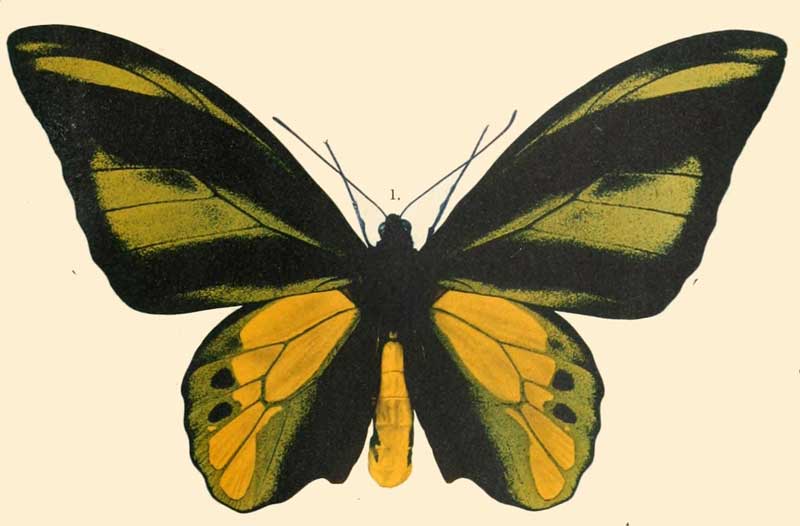
Superregnum: Eukaryota
Cladus: Unikonta
Cladus: Opisthokonta
Cladus: Holozoa
Regnum: Animalia
Subregnum: Eumetazoa
Cladus: Bilateria
Cladus: Nephrozoa
Cladus: Protostomia
Cladus: Ecdysozoa
Cladus: Panarthropoda
Phylum: Arthropoda
Subphylum: Hexapoda
Classis: Insecta
Cladus: Dicondylia
Subclassis: Pterygota
Cladus: Metapterygota
Infraclassis: Neoptera
Cladus: Eumetabola
Cladus: Endopterygota
Superordo: Panorpida
Cladus: Amphiesmenoptera
Ordo: Lepidoptera
Subordo: Glossata
Cladus: Coelolepida
Cladus: Myoglossata
Cladus: Neolepidoptera
Infraordo: Heteroneura
Cladus: Eulepidoptera
Cladus: Ditrysia
Cladus: Apoditrysia
Cladus: Obtectomera
Superfamilia: Papilionoidea
Familia: Papilionidae
Subfamilia: Papilioninae
Tribus: Troidini
Subtribus: Troidina
Genus: Ornithoptera
Subgenus: Schoenbergia
Species: Ornithoptera chimaera
Formae loc.: O.c. f. loc.charybdis - O.c. f. loc.chimaera - O.c. f. loc.dracaena - O.c. f. loc.flavidior
Name
Ornithoptera chimaera (Rothschild, 1904)
Synonyms
Troides chimaera Rothschild, 1904
Ornithoptera (Schoenbergia) chimaera (Rothschild, 1904)
Papilio (Troides) chimaera dracaena Joicey & Talbot, 1922
Type locality: Indonesia, Irian Jaya, Weyland Mountains, Dewaro Village, 3500 ft.
Types: HMW. two (2) males ♂♂ and four (4) females ♀♀. VI.1920.
References
Deslisle, G. & Sclavo, J.P. 2015. Outstanding Birdwing Butterflies. Volume 1: 1–813. Reference page.
Schäffler, O., 2001: Papilionidae VI, Ornithopthera in Bauer & Frankenbach, Butterflies of the World. part 12.
Vernacular names
English: Chimaera Birdwing
Ornithoptera chimaera, the chimaera birdwing, is a birdwing butterfly of the family Papilionidae. It is found in mountain areas of New Guinea, 1000 meters above sea level.
The "chimaera" portion of both the scientific and vernacular name, is named after the Chimaera, Greek: Χίμαιρα, Khimaira, from χίμαρος, khimaros, a creature in Greek mythology, composed of parts of three animals.
Description
For explanation of terms, see External morphology of Lepidoptera.
As Schoenbergia chimaera, male in Robert Henry Fernando Rippon's Icones Ornithopterorum (1898 to 1906)
Ornithoptera chimaera is sexually dimorphic. The wingspan is 80–180 mm in females and 70–150 mm in males.
Male: The forewings are ground colour black. There are two green areas. The underside of the forewing is green. The margin of the wing is black. The veins are black. There is a chain of little postdiscal internervular black spots on the wing. The hindwing inner part and the edge are black. The other part of the wing is green and contains some large, golden spots and two or more black spots. The underside of the hindwing is green. There are large, golden spots and three black spots. The inner edge is very hairy.
The abdomen is bright yellow. Head and thorax are black. The underside of thorax has two red tufts.
Female: The female is larger than the male. The general colour of the female is dark brown. There is a chain of white postdiscal spots on the forewings, a discal chain and white subcostal spots. In the discal part of the hindwings there is a large, white area. The outer edge of this white area is yellow. Between the white part and the yellow part there is a chain of black spots.
Subspecies
Ornithoptera chimaera chimaera
Ornithoptera chimaera charybdis (van Eecke, 1915)
Ornithoptera chimaera flavidior Rothschild, 1913
Type material
The holotype is in the Natural History Museum, London.
Biology
Female
O. chimaera is a montane species found in the Central Range montane rainforests. The larvae feed on species of the genus Aristolochia including Aristolochia momandul. The female lays up to 20 eggs on the leaves. Adults feeds upon the nectar of Spathodea (an invasive species) and Hibiscus. Groups of both sexes can be seen circling the tops of these trees in the canopy.
Conservation
The chimaera birdwing is listed on CITES Appendix II, restricting international trade to those who have been granted a permit.[3] It is also regarded at near threatened by the IUCN.[1] The chimaera birdwing is listed on Appendix II of the Convention on International Trade in Endangered Species, which serves to regulate the trade in the species or any of its parts by requiring export licences and producing quotas[4]
See also
Fauna of New Guinea
References
Böhm, M. (2018). "Ornithoptera chimaera". IUCN Red List of Threatened Species. 2018: e.T15516A727316. doi:10.2305/IUCN.UK.2018-1.RLTS.T15516A727316.en. Retrieved 18 November 2021.
"Appendices | CITES". cites.org. Retrieved 2022-01-14.
CITES appendices I, II and III, Version 27 April 2011.
Sands, Donald P. A.; New, Tim R. (2013), "The Richmond Birdwing Butterfly", Conservation of the Richmond Birdwing Butterfly in Australia, Dordrecht: Springer Netherlands, pp. 29–48, doi:10.1007/978-94-007-7170-3_2, ISBN 978-94-007-7169-7, retrieved 2020-10-15
CITES (May, 2005) http://www.cites.org
D'Abrera, B. (1975) Birdwing Butterflies of the World. Country Life Books, London.
Haugum, J. & Low, A.M. 1978-1985. A Monograph of the Birdwing Butterflies. 2 volumes. Scandinavian Press, Klampenborg; 663 pp.
Straatman, Raymond; & Schmid, F.,1975 Notes on the biology of Ornithoptera goliath and O. chimaera (Papilionidae). Journal of the Lepidopterists' Society 29: 85-88.pdf[permanent dead link]
Thomas Graham Howarth, 1977 A list of the type-specimens of Ornithoptera (Lepidoptera: Papilionidae) in the British Museum (Natural History) Bulletin of the British Museum (Natural History). Entomology series 36:153-169 pdf
Retrieved from "http://en.wikipedia.org/"
All text is available under the terms of the GNU Free Documentation License

